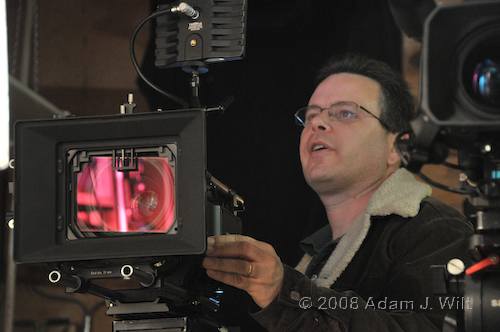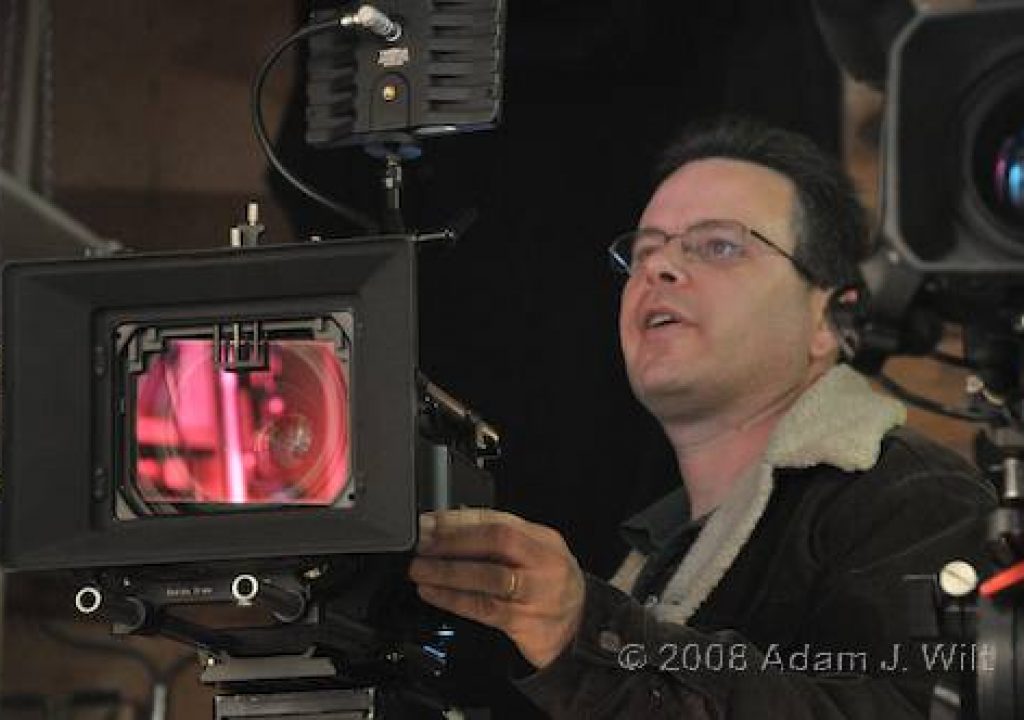
Art Adams with the 486 filter on a RED ONE
Last week, Art Adams, Tim Blackmore, Ted Allen, and I tested the Schneider 486 UV/IR cut filter on a RED ONE and on a Sony PMW-EX1. Tim wore his famous “doesn’t look anything like that in real life” “black” shirt, and we lit him with IR-rich incandescent sources.
Tim Blackmore in the hot seat at Videofax.
Tim’s shirt appears black to the eye, as it does to the Nikon D300 DSLR:
Tim and friends as seen by the Nikon D300.
But his shirt uses a fabric or dye that reacts strongly to IR and/or UV, reflecting a lot of energy back to the camera that’s outside of the human eye’s passband, but well within the limits of what a CCD or CMOS sensor can see. We have noticed that many cameras see that shirt as a reddish-brown, especially when ND filters are used (as they were in the outdoor shots in the three-camera comparison, to get all the lenses opened to T2.8). And while the RED actually does a better job than other cameras we’ve aimed at that shirt, even the RED’s rendition starts drifting when heavy ND filtration is used.
Art obtained a Schneider 486 UV/IR Cut filter from Schneider’s booth at NAB, and we showed up at Videofax to try it out on both the RED and on the Sony PMW-EX1.
Our first surprise, upon setting up, was seeing that the RED saw Tim’s shirt as a shade of blue, neither neutral black nor reddish-purple. Furthermore, the 720p monitoring output seemed to accentuate the green-magenta axis excessively, more so than the onboard LCD did. Quick off-the-monitor shots from both the RED and a Varicam that Videofax’s Jim Rolin set up for us confirmed that (a) the RED saw Tim’s shirt as blue while the Varicam (like other video cameras) saw it as being reddish-purple, and (b) the RED’s monitor output exaggerated the green-magenta axis.
RED’s monitor output: exaggerated green & magenta; blue shirt.
Varicam’s rendition: less color exaggeration, red/purple/brown shirt.
We shot Tim with RED and a 28mm Ultra Prime, with and without the 486 filter:
Tim without any filtration, RED.
Tim with the 486 filter, RED.
In my frame grabs, I’ve color-corrected both shots to match on the grayscales; seen uncorrected, the 486 filter imparts a slight green/cyan cast (as you might expect, since its visible reflectance is red/orange).
With no NDs in place, the 486 had only a minimal impact on RED’s colors; it pulled a slight bit of purple from Tim’s shirt, but the shirt still reads as blue.
Next: the PMW-EX1; RED with NDs; wide-angle lensing.
On the Sony EX1, the results were far more dramatic:
Tim without any filtration, PMW-EX1.
Tim with the 486 filter, PMW-EX1.
Again, I’ve color-corrected the two shots to match, and I apologize for the slapdash framing and exposure: I simply fired up the EX1 handheld, and held the filter in front of it.
Even with no NDs in place, Tim’s shirt reads as a vibrant reddish purple to the EX1; but with the 486 filter interposed, his shirt looks just like it does to the eye.
The Varicam reacted pretty the same way as the EX1 (as did both the HVX200 and the F23 in previous tests), seeing Tim’s shirt as red/purple/brown. The 486 filter tamed the Varicam’s color, making the shirt neutral, just as effectively as it did on the EX1.
We then took the RED outside and shot Tim in sunlight, with about (as I recall) 4+ stops of ND in place, using both the strongest ND filter we could find, and a polarizer (Art should be able to tell us what the exact filter factor was when he has the time to write up his findings). Here, the 486 filter made a much more noticeable improvement in the image:
Tim with heavy ND, no 486 filter, RED.
Tim with heavy ND and the 486 filter, RED.
The numbers on the slate indicate the RED’s white balance settings with and without the filter.
In post, I white-balanced both shots on Tim’s hair and the table in the background and tried to match skin tones; it’s arguable whether one might wish to track the foliage a bit more closely instead. In any case, the difference in Tim’s shirt is clear; the 486-filtered version is much closer to the “truth” as our eye see it. But it’s still a bit blue, if not blue enough to be a serious concern.
Looking at these results, Art said, “why would I ever want to shoot without this filter?” For the most part, I agree: it vastly improves color accuracy when IR-reflective fabrics or dyes are present.
There are a couple of times when you might not want to use it: when shooting IR footage (Jeff Kreines, I know you’re out there!), or when shooting a very wide angle.
At Chater Camera the next day, I plopped the 486 in front of a 16mm Zeiss Ultra Prime mounted on a RED. At the extreme outer edges of the image, there’s a slight green/cyan vignetting effect (Schneider warns of this in their app note, previously linked):
Tim at 16mm without any filtration, RED 4K.
Tim at 16mm with the 486 filter, RED 4K.
(Those two metal gun barrels pointed at Tim? Those are the matte box rails. A 16mm lens is wide!)
The color vignetting is subtle, and could probably be taken out with a simple secondary color correction, but as John Chater said, “my DP clients don’t want the hear the term ‘secondary correction’ because all it means to them is more dollars spent in post!” And that, of course, is assuming they even get the chance to have any secondary correction done in the first place.
What’s really interesting to me is how good the RED is at rejecting IR compared to standard video cameras; you really have to pile on the ND to cut visible light down before the IR in a scene is strong enough to noticeably affect the picture, whereas the video cameras we’ve used have all seen the IR without any special efforts to accentuate it. The RED folks have been saying all along that they have strong IR filtration on board (and the red light reflected from the RED’s sensor is a likely indicator of this), and indeed they have apparently done a better job of this than have many others.
So yes, I’d say the 486 filter (or the upcoming Schneider “True-Cut IR filter”, without the UV filtration), or the comparable Tiffen IR cut filter (which Art was unable to pry out of the Tiffen folks at NAB, grin) is well worth having on hand, both for the RED when the NDs get heavy, and also for just plain ol’ video cameras, all the time.

